Leveraging AWS Lambda SnapStart with the Micronaut Framework
by Sergio Del Amo CaballeroDeveloping and deploying AWS Lambda functions with the Micronaut framework have been possible either with the Java runtime, or by deploying a native executable built with GraalVM to a custom runtime. The latter provides faster cold starts.
When a Lambda function is invoked for the first time or scales up, an execution environment is created. The first phase in the execution environment’s life cycle is initialization (Init). For applications deployed on Java-managed runtimes, a new JVM is started, and your application code is loaded. This is referred to as a cold start.
SnapStart
Today, AWS has announced Lambda SnapStart, an opt-in feature of AWS Lambda, which delivers up to 10x faster startup performance for latency-sensitive Java applications.
When SnapStart is enabled, function code is initialized once when a function version is published. Lambda then takes a snapshot of the memory and disk state of the initialized execution environment, encrypts snapshot, and caches it for low-latency access. When the function is first invoked or subsequently scaled, Lambda resumes new execution environments from the cached snapshot instead of initializing from scratch, avoiding several seconds of variable latency.
You can enable SnapStart using a function-level opt-in switch in the AWS CLI, Lambda Console, Lambda API, AWS SDK, AWS CloudFormation, AWS SAM, and AWS CDK.
In this article, we describe how SnapStart dramatically reduces your cold starts for AWS Lambda Functions developed with the Micronaut framework and deployed to the Java runtime.
Micronaut deployment options for AWS Lambda
You can deploy a Micronaut application as a FAT jar to the AWS Lambda Java runtime or as a native executable built with GraalVM to a custom AWS Lambda runtime. A native executable deployed to a custom runtime offers fast cold starts. With the release of SnapStart, developers can deploy to the Java runtime and enjoy fast cold starts as well.
Hello World Performance
The following diagram shows cold starts improvements for a Hello World application. In this article, we will compare closer to a production scenario.
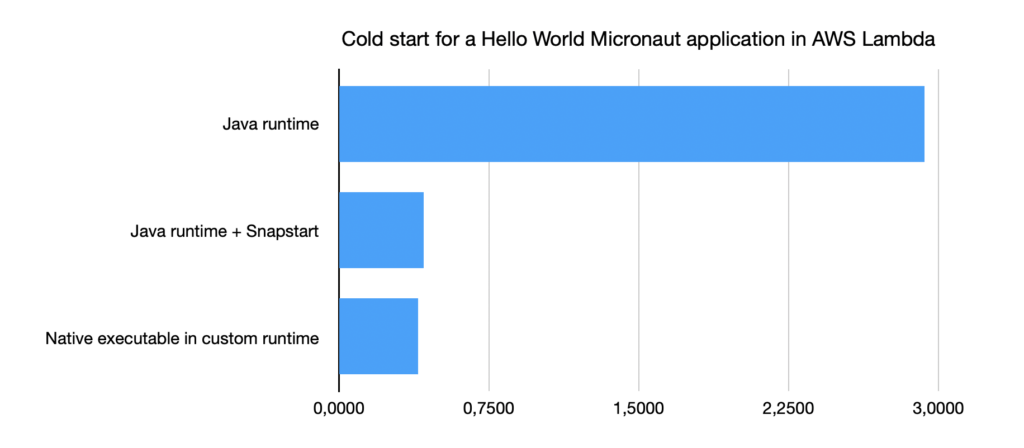
Sample application
In this blog, we compare the performance of a sample application deployed to AWS Lambda.
Application Size
We will show a comparison with an application closer to a production scenario, rather than using a Hello World application. This sample application contains more than 60 Java classes and more than 2000 lines of Java code.
Architecture
The application’s architecture features an Amazon API Gateway proxying to a Lambda function which reads and writes to a DynamoDB table.

Dependencies
Moreover, it adds many dependencies you may find in your Micronaut applications:
The application exposes a JSON API and renders server-side HTML to present forms and visualize data.
Build
The Micronaut framework is built agnostic. You can build Micronaut functions with Maven or Gradle and deploy them to AWS Lambda. For the sample application in this article, we used Gradle. It is a multi-module build. Each of the deployments shares the same code.
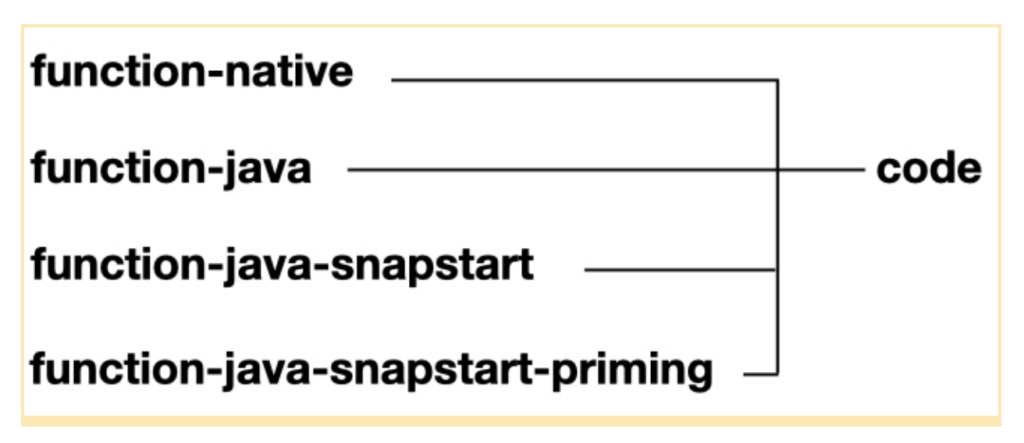
Infrastructure as Code
The Micronaut framework integrates with Amazon CDK. The module infra contains the code which creates the infrastructure described in the previous architecture.
Here are README.md instructions to run the comparison in your own AWS account seamlessly, as it is described in this article.
Load Tests
The project contains a module named loadtests which uses Gatling, a powerful open-source load testing solution, to invoke the Lambda function.
The load test runs a POST, GET, DELETE scenario with 50 concurrent users for 3 minutes and then ramps up to 100 concurrent users for 2 additional minutes.
Max Cold Start Comparison
The following diagram compares the max cold startup during the load test for four deployment scenarios:
- Java application deployed to Java Runtime
- Java application deployed to Java Runtime plus SnapStart
- Java application deployed to Java Runtime plus SnapStart plus Priming (Performance Tuning).
- Native executable built with GraalVM deployed to a custom Runtime
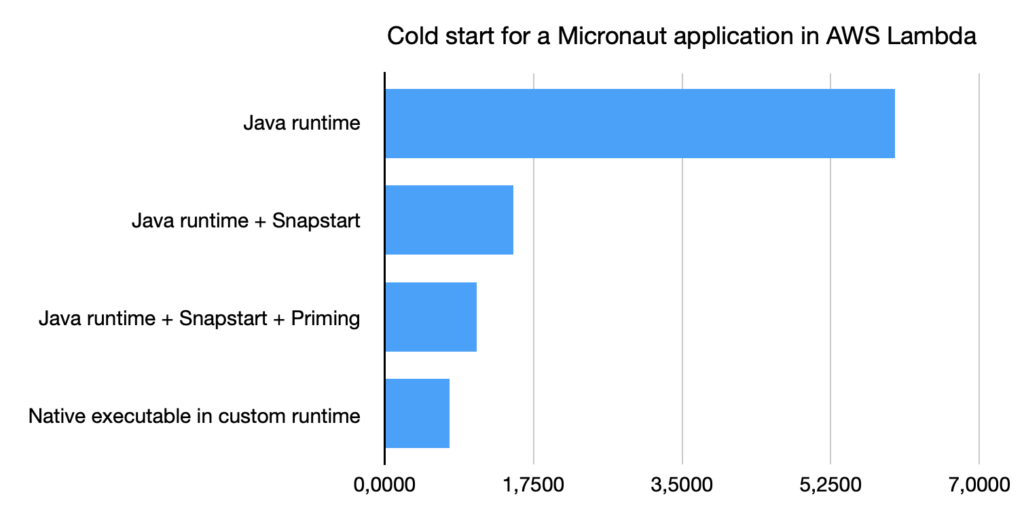
Using the Java runtime and SnapStart offers them dramatic cold starts improvements.
Cold Starts
Cold starts are a rare occurrence. You can see this reflected in the following diagram below. The load test shows 99.9% of requests are served in less than 83ms.
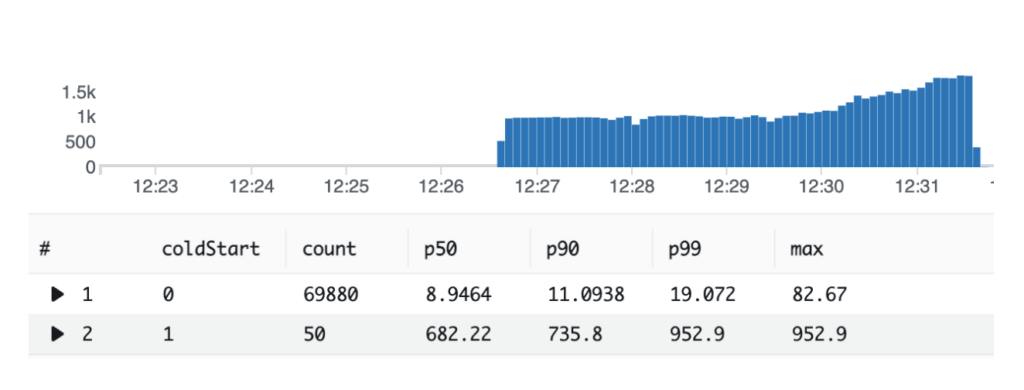
The max cold start is calculated by running a Cloud Watch Log Insights query. For functions with SnapStart enabled:
filter @message like "REPORT" | filter @message not like "RESTORE_REPORT" | parse @message /Restore Duration: (?<@restore_duration_ms>[0-9\.]+)/ | parse @message / Duration: (?<@invoke_duration_ms>[0-9\.]+)/ | fields greatest(@restore_duration_ms, 0) as restore_duration_ms, greatest(@invoke_duration_ms, 0) as invoke_duration_ms | fields restore_duration_ms + invoke_duration_ms as total_invoke_ms | stat max(total_invoke_ms) as max
For functions without SnapStart enabled:
filter @type="REPORT" | fields greatest(@initDuration, 0) + @duration as duration | max(duration) as max
Read more about Monitoring for SnapStart.
SnapStart Runtime Hooks and CRaC integration
Fortunately, the Micronaut framework already offers CRaC integration via the module Micronaut CRaC.
Once you add the Micronaut CRaC dependency to your build, SnapStart invokes each CRaC resource before creating a snapshot (checkpointing when the function version is being published) or while restoring the snapshot (upon function invocation).
To define a CRaC resource, create a bean of type io.micronaut.crac.OrderedResource The following bean does some simple logging:
package example.micronaut;
import io.micronaut.crac.OrderedResource;
import jakarta.inject.Singleton;
import org.crac.Context;
import org.crac.Resource;
import org.slf4j.Logger;
import org.slf4j.LoggerFactory;
import java.util.Map;
@Singleton
public class LoggingResource implements OrderedResource {
private static final Logger LOG = LoggerFactory.getLogger(LoggingResource.class);
@Override
public void beforeCheckpoint(Context<? extends Resource> context) throws Exception {
LOG.info("before creating a snapshot");
}
@Override
public void afterRestore(Context<? extends Resource> context) throws Exception {
LOG.info("restoring the snapshot");
}
}
Performance Tuning (Priming)
You can use a CRaC resource to exercise your Java code before creating a snapshot for performance tuning.
To maximize the benefits of SnapStart, we recommend that you preload classes that contribute to startup latency in your initialization code instead of in the function handler. This moves the latency associated with heavy class loading out of the invocation path, optimizing startup performance with SnapStart.
The priming variant of the sample application adds a resource which saves and deletes a todo from the DynamoDB table.
@Singleton
public class PrimingResource implements OrderedResource {
...
..
.
@Override
public void >beforeCheckpoint>(>Context><? >extends >Resource>> context) throws Exception {
LOG.info("priming...");
OauthUserUtils.parseOAuthUser(authentication()).ifPresent(user -> {
String todoId = todoSaveService.save(new TodoCreate(randomAlphanumeric(20)), user);
todoRepository>.delete(>todoId>, user);
});
LOG.info("finished priming");
}
.
..
...
}
Exercising the Java code before a snapshot can lead to a faster restoration from a snapshot.
Differences between the applications
The build of the modules function-java and function-java-snapstart, and function-java-snapstart-priming applies the Micronaut Gradle plugin io.micronaut.minimal.application and it configures the Micronaut extension with:
micronaut {
runtime("lambda_java")
}
The build of the module function-native, responsible of generating the native executable with GraalVM, applies the Micronaut Gradle plugin io.micronaut.application and it configures the Micronaut extension with:
micronaut {
runtime("lambda_provided")
}
When you use lambda_provided as your runtime, the Micronaut Gradle Plugin adds transparently extra dependencies to your build, such as io.micronaut.aws:micronaut-function-aws-custom-runtime, which is not necessary when deploying to a Java runtime.
SnapStart differences
The only difference between function-java and function-java-snapstart or function-java-snapstart-priming is the addition of the Micronaut CRaC dependency and the classes LoggingResource or PrimingResource mentioned in the previous sections.
Micronaut CRaC dependency is only necessary if you want to leverage SnapStart runtime hooks.
GraalVM Native Executable differences
The application uses Thymleaf as a template rendering engine. Thymeleaf accesses some of the application’s classes using reflection. To make the application work as a native executable, a reflection configuration file was generated.
The Micronaut framework provides several annotations @TypeHint, @ReflectiveAccess, and @ReflectionConfig, to ease the generation of such reflection configuration for you.
Deployable artifact generation
To generate deployable artifacts, I use the Gradle task ./gradlew function-java:shadowJar for both function-java, function-java-snapstart and function-java-snapstart-priming.
For function-native, I run the ./gradlew function-java:buildNativeLambda.
The generation of a native executable with GraalVM is slower than a FAT JAR.
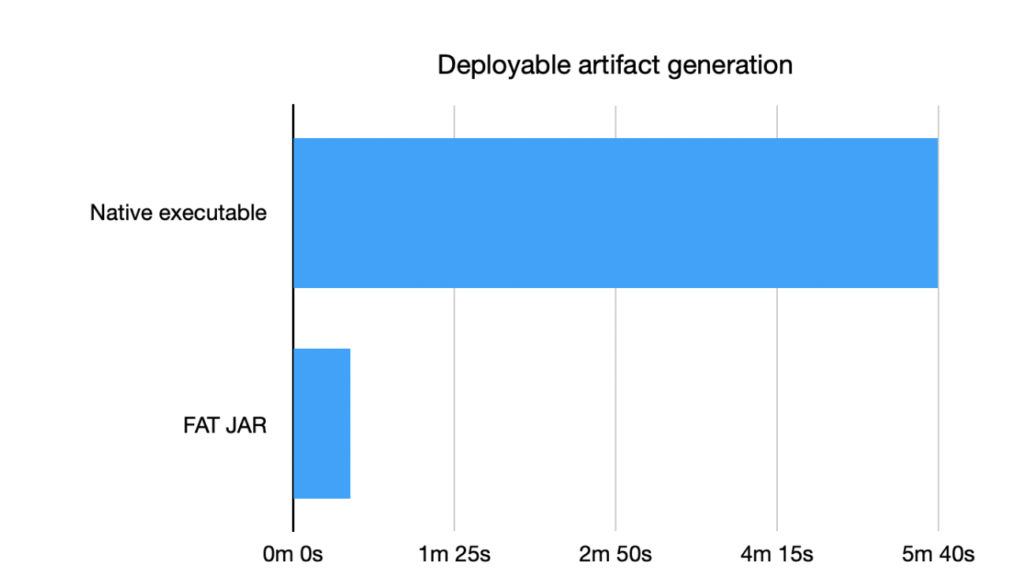
The above image shows build times which will change depending on your hardware.
Memory
This blog post comparison uses identical Lambda Memory settings: 2024 MB.
However, a native executable deployed to a custom runtime has a lower memory requirement. Thus, you could get the same performance with smaller memory and, therefore, cheaper.
Resources
- App in this article
- AWS Lambda SnapStart
- Micronaut AWS Lambda
- Micronaut Guides for AWS Lambda
- Micronaut CRaC
Conclusion
In this article, we have seen how AWS Lambda’s new feature SnapStart improves the cold start performance of Java applications that are running on AWS Lambda. We compared the same code with the Java Runtime, Java Runtime plus SnapStart and a Native executable in a custom runtime.
We have also seen how to use Micronaut CRaC to help us create runtime hooks for AWS SnapStart, further to improve performance or execute logic before or after snapshot creation.
AWS Lambda SnapStart greatly reduces cold starts for Java. This is an exciting opportunity for JVM developers to unleash the full potential of AWS Lambda for Java. The Micronaut framework helps you do just that.